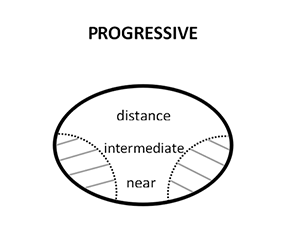FAQ
Quick Links
How to adjust to progressive glasses or bifocals?
Your vision may change as you age. You'll know it's happening when have to hold farther away just to read it. This is called presbyopia. It's normal, and almost all of us get it as we reach the middle 40's.
Reading glasses can help read clearly. But if you want to see clearly at a different distance in just one pair of glasses, then bifocals or progressive glasses may do the trick. They're also called multifocal glasses.
Bifocals have two fields of vision: the upper for distance and the lower for up close. There is a visible line across the middle that divide the two corrections.

Progressives have a gradual or progressive change in vision in different parts of the lens, so there's no visible line on the lenses.
Progressive lenses have three fields of vision and tend to be blurry on the sides of the lens. You see far away through the upper lens and up close through the lower. The intermediate-range of the lens is used to see your laptop or something in the range of 20 inches to 40 inches (50 cm - 100cm) away from your eyes.

Short-Term Side Effects
You may need some time to adjust to your multifocals. Most people get used to them after a week or two, but it can take longer. A few people never like the changes in vision and give up on bifocals or progressives.
At first, you may notice these:
• Blurry vision
• Objects that seem to jump or move around
• Headaches
• Nausea
• Balance problems
Bifocals or progressives may change the way you judge distance or depth as you look down through the bottom of the lens. So it takes a longer adjustment period than single vision glasses.
How to Adjust
Don't give up on your new lenses. Take these steps to get used to them, and you will enjoy a clear vision with bifocals and progressives.
1.Try putting on bifocals or progressives first thing in the morning and wear them for just an hour or two. The next morning, try a few more hours. Slowly build up your tolerance to adjust to them.
2.Don't switch between your new glasses and your old ones.
3.Make sure your new eyeglasses fit properly and don't slide down your nose.
4.When you walk, look straight ahead, not down at your feet. Also work on pointing your nose in the direction you want to look, not just looking left or right with your eyes. You cannot see clearly through the peripheral lenses.
5.When you read, hold the items down and about 16 inches away from your eyes. Look through the bottom of your lenses. (the bottom is for reading)
6.Don't move your eyes or head while you read. Move the page or paper instead.
7.Set your computer screen just below eye level. You can adjust your desk or chair.
8.Talk to your eye doctor if your lenses still bother you after a few weeks. You may need to change your prescription strength.










